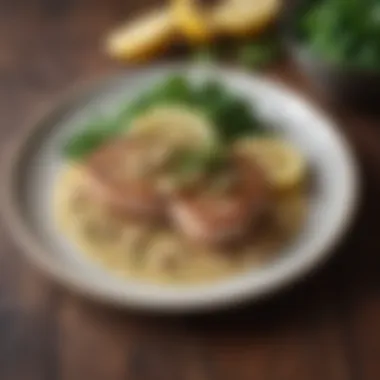Exploring Pork Piccata: A Culinary Guide to Flavor


Intro
Pork piccata presents a harmonious blend of simplicity and depth, captivating palates with its distinct flavor. This dish not only emphasizes the flavor profiles inherent in pork but also utilizes commonly available ingredients to elevate an ordinary meal into an extraordinary culinary experience. Understanding the essence of pork piccata involves delving into its ingredients, methods of preparation, personalizations, and dietary adaptability. Each facet holds importance, enriching your comprehension of this dish.
Ingredients Breakdown
A robust foundation of any dish starts with its ingredients. For pork piccata, selecting the right components is crucial to develop its remarkable taste and texture.
Primary Ingredients
- Pork Chops: The centerpiece of the dish. Selections such as boneless pork loin or shoulder chops work best due to their thickness and juiciness.
- Lemon: Freshly squeezed lemon juice adds necessary acidity, enhancing the rich flavors of the pork.
- Capers: Brined capers provide a salty, unique flavor contrast that is vital for authenticity.
- Olive Oil and Butter: This mixture enriches the flavor and ensures a beautiful sear.
Optional Ingredients
- Parsley: Fresh parsley can serve as a garnish, adding a pop of color.
- Garlic: A clove of minced garlic will introduce aromatic qualities.
- Stock (Chicken or Vegetable): A splash of stock in the sauce can deepen the overall profile.
Essential Kitchen Tools
- Skillet: A heavy skillet will provide even cooking and browning.
- Meat Mallet: Helpful for tenderizing the pork chops before cooking.
- Juicer: To obtain fresh lemon juice quickly.
Step-by-Step Preparation
Proper preparation and cooking steps will ensure your pork piccata is executed flawlessly.
Prepping the Ingredients
Begin by preparing the pork. Use a meat mallet to pound the pork chops to a uniform thickness. This helps in even cooking.
- Season the pork with salt and pepper.
- Juice the lemons to have enough for your sauce and garnish.
Cooking Techniques and Methods
The cooking of the pork is pivotal. Firstly, heat the olive oil and a tablespoon of butter in a skillet over medium-high heat until shimmering.
- Add pork chops to the skillet, cooking until both sides are golden brown.
- Remove pork from the skillet and keep warm.
- In the same skillet, add lemon juice, capers, and stock if using. Scrape any browned bits from the bottom to flavor the sauce more.
Assembly and Presentation Tips
Once the sauce is finished, return the pork to the skillet for just a minute to combine the flavors. Plate the pork piccata promptly. Garnish with fresh parsley and serve with a wedge of lemon on the side for zest and color.
Dietary Considerations
Understanding dietary needs keeps pork piccata inclusive for everyone.
Gluten-Free Options
Pork piccata is naturally gluten-free for those following that diet, as most ingredients do not contain gluten.
Vegetarian and Vegan Substitutes
Replacing pork can be completed with mushrooms or tofu. Marinating them in lemon juice, then following the same preparation method can yield satisfying results.
Nutrition Facts & Nutritional Considerations
For enthusiasts keen on nutrition, a standard serving could be around 275 calories, providing good doses of protein and fats while being lower in carbohydrates. Balancing this with healthy sides can round out any meal easily.
Variations and Customizations
Adapting the dish can pave way for unique interpretations suited to various tastes.
Flavor Enhancements
- You can add a splash of white wine to the sauce for added depth.
- Consider switching the capers for olives for a different briny flavor.
Alternative Cooking Methods
Grilling the pork instead of pan-searing can bring a new smoky flavor. Moreover, braising could offer tenderness and richness.
Pairing Suggestions (Sides, Drinks, etc.


) Dining excellence is achieved through proper pairings:
- Sides: Serve with sautéed vegetables, rosemary potatoes or a light salad.
- Drinks: Pairing with crisp white wines like Sauvignon Blanc rounds off the dish harmoniously.
Common Answers to Common Questionss and Troubleshooting
Across cooking gears many questions can arise.
Frequently Asked Questions
Is pork piccata hard to make? No, with practice and understanding of the process, it becomes simple.
Common Mistakes to Avoid
- Overcrowding the skillet can wear down the sear quality of the pork.
- Rushing the sauce preparation will undermine flavor integration.
Solutions to Potential Problems
If the sauce is too sour, adding a dash of sugar can balance flavors effectively.
Pork piccata industrially combines simple technique with sophisticated taste, holding a precious place in both home cooking and as classic dish. Embracing its craft allows one to celebrate culinary tradition in a practical and delightful manner.
Prologue to Pork Piccata
Pork piccata captures the essence of culinary simplicity while offering a layer of depth in flavor. This dish presents an excellent fusion of juicy pork, zesty citrus, and fragrant herbs, making it a much-loved favorite in various settings, from casual family dinners to lavish gourmet gatherings.
Understanding pork piccata means appreciating its versatile components. The choice of pork can affect the texture and richness of the dish. Thin cuts like pork loin provide a tender bite that absorbs the bright, acidic sauce beautifully. Citrus elements, primarily lemon, bring brightness and cut through the richness of the meat. Similarly, herbs elevates the dish, both in aroma and taste.
The preparation techniques can make or break this dish. Mastering even the small details, such as marinating pork and balancing compiling flavors in the sauce, is what ensures a memorable pork piccata. Additionally, suitable accompaniments enhance the eating experience, acting as a beautiful canvas upon which the main flavors can stand out.
This introduction is just a glimpse into a more detailed exploration ahead. Embracing issue faults and considering nutritional profile provides insights on dietary adjustments or culinary experimentation. Ultimately, pork piccata combines rich traditions and modern techniques that can captivate any foodie.
To truly enjoy pork piccata, one must engage not only with the dish but with the storytelling surrounding it, bridging diverse culinary perspectives.
Historical Background
Understanding the historical background of pork piccata adds valuable context to its enjoyment and preparation. To appreciate the flavors and techniques involved in this dish, one must consider its roots and how they shaped its development over the years. This knowledge broadens culinary horizons and deepens appreciation for the craftsmanship behind each plate.
Origins of Piccata
Piccata is a term that originally comes from Italian cuisine, specifically referring to dishes that use a method of slicing and lightly frying meat. The concept dates back several centuries. Early versions may not have even used pork as a primary ingredient. Instead, veal was often the protein of choice in traditional piccata recipes.
The term "piccata" itself is derived from the Italian word piccare, which means to prick or puncture. This suggests a technique that includes slicing the meat thinly or pounding it for tenderness. Different regions of Italy put their unique spin on the dish, contributing to its rich evolution over time. Through immigration and globalization, the technique spread across communities and adopted various influences.
Evolution of the Dish
As piccata made its way through different cultures, particularly during the 19th and 20th centuries, recipes and preparations adapted. The infusion of new flavors, ingredients, and styles led to the creation of numerous variations, including the contemporary pork piccata. The traditional method often involved capers, lemon juice, and butter, elevating the simplicity of meat preparation into something zesty and vibrant.
In American kitchens, the adaptation of using pork became more common. This shift allowed for a daily dish that could easily be accessed and enjoyed at various meal occasions, not only in special settings. Today, it represents an intersection of tradition and innovation, capturing elements of Italian heritage while remaining relevant to modern palates. A good understanding of its historical development thus sets the foundation for creating authentic meals that honor this cuisine's heritage.
Pork piccata reflects the journey of food through history, where flavors mingle and evolve into beloved dishes across cultures.
Key Ingredients
The foundation of any good dish lies in its ingredients. In the case of pork piccata, selecting the right components is crucial. Each ingredient not only contributes to flavor but also adds texture and enhances the overall meal presentation.
Pork Selection
When it comes to choosing pork for piccata, quality is vital. Look for cuts like boneless pork loin or tenderloin. These options provide tenderness and lean meat, which are important to avoid a dry result. The fat ratio plays a role in the final outcome. A small amount of fat can help enhance the flavors without making the dish overly greasy.
Marinating the pork can elevate its taste. Consider a simple overnight marinade comprising olive oil, lemon juice, and garlic. This step can enhance the tenderness of the meat while infusing it with subtle flavors. The act of marinating also helps to create a nice sear when cooking, which contributes to the dish's overall appearance and flavor profile.
Citrus Elements
Citrus is a defining characteristic of pork piccata. The primary citrus element is lemon, often showcased in the form of juice and zest. The freshness and acidity of lemon distinguish the dish. They cut through the richness of the pork, balancing the flavors wonderfully.
Lime can be used as an alternative for an interesting twist. The combination of lime juice with cilantro and jalapeño offers another layer of flavor to experiment with. Different citrus fruits like blood oranges or grapefruits can also add incira like uniqueness. It’s vital to understand the role of fresh citrus as it ties the whole dish together.
Herbs and Seasoning


Simple herbs do not to be overlooked. In pork piccata, parsley is commonly used for garnish and to introduce freshness. Fresh herbs help make the plate look appealing. Freshness plays off the pork's flavors better than dry variations.
Additionally, capers are a classic addition, bringing a briny contrast. This unique flavor profile usually resonates well in Parker Piccata. Garlic lends its robustness profoundly as well. Salt and pepper remain indispensable; good seasoning can elevate even mundane elements into star components. Make sure to season pork adequately before cooking and adjust according to taste when preparing sauce as well.
It's important to balance flavors, ensuring that none dominate the dish while harmonizing beautifully with each other.
Together, these ingredients lay the groundwork for making a delectable pork piccata. Confidently selecting and preparing them will reveal the full potential this dish can offer.
Preparation Techniques
Understanding the preparation techniques for pork piccata is essential for both beginners and seasoned cooks. Each technique plays a vital role in ensuring the meat remains flavorful and tender, creating a well-balanced dish. Proper techniques also help to highlight the dish's distinctive taste, making it memorable.
Marinating the Pork
Marinating pork is a crucial step in the preparation process. It allows the flavors from herbs, spices, and acidic ingredients, such as lemon juice, to penetrate the meat. This enhances the overall flavor and tenderizes the pork, making it more enjoyable in the final dish.
Benefits of Marinating:
- Improves Flavor: Keeps pork juicy and infuses it with numerous taste inputs.
- Breaks Down Fiber: The acid in the marinade helps soften the meat.
- Longer Cooking Times: Enables the dish to be forgiving when undercooked as the marinating process tenderizes it well.
When marinating pork ribs, it's suggested to let the meat sit for at least an hour, but overnight for optimal results. Homemade marinades often include olive oil, garlic, and fresh herbs such as parsley or oregano to create a robust flavor profile.
Cooking Methods
The way pork piccata is cooked greatly influences its final presentation and taste. Two popular cooking methods are pan-searing and oven baking, both offering unique advantages.
Pan-searing
Pan-searing is a technique that involves cooking the pork in a hot skillet, typically with a small amount of oil, until a golden-brown crust forms. This method allows for superior caramelization, enhancing the dish's flavor complexity.
- Key Characteristic: Quick Cooking Time
- Benefits: Promotes browning and develops rich flavors through the Maillard reaction.
- Disadvantages: Requires careful attention to prevent overcooking me depending on thickness.
The crisp exterior of the pork gives an appealing texture, making it a favored choice for this dish.
Oven Baking
Oven baking involves slow cooking the meat at a consistent temperature. This method ensures even cooking throughout the cut and can maintain moisture levels in the pork.
- Key Characteristic: Even Heating
- Benefits: Prepares greater quantities in one session; effectively retains moisture.
- Disadvantages: Less control over browning; the texture may not be as crispy.
Utilizing this method can benefit busy cooks wanting to prepare multiple components of a dish simultaneously without worry of burning.
Creating the Sauce
The sauce in pork piccata should complement the pork rather than overpower it. A combination of citrus juice, butter, garlic, and capers leads to a harmonious, zesty affair.
This combination accentuates the flavors of the meat, offering a bright yet creamy dimension that encapsulates the essence of pork piccata.
Hence, mastering the preparations will elevate your ability to execute the dish admirably. With a framework like this, both newer and adept cooks can find a common ground in this culinary adventure.
Variations of Pork Piccata
Understanding the variations of pork piccata is crucial to appreciating the dish's versatility and richness. Comparing traditional preparation methods allows both novice and seasoned chefs to explore adaptations that suit their tastes and dietary needs. This section focuses on two main categories of variations: regional adaptations and health-conscious modifications. Each carries its own significance, showing how the core principles of pork piccata can be tailored while retaining its essence.
Regional Adaptations
Pork piccata, while rooted in Italian cuisine, invites numerous regional adaptations that reflect local ingredients and culinary traditions. For instance, some areas might incorporate more robust herbs, while others may emphasize the zesty fiavor of citrus fruits. The dish finds unique expressions across diverse cultures.
In Italy, particularly in the south, one might encounter versions made with pork marinated in white wine in addition to the classic lemon. In contrast, coastal regions could introduce seafood such as shrimp, blending classic piccata techniques with fresh captures from the ocean.
These adaptations spotlight the ability to personalize pork piccata, enhancing its flavor and making it compatible with local cuisines. Understanding these variations leads to a richer cooking experience, as one learns how to adapt recipes based on available ingredients or personal preferences.
Additionally, it's beneficial to pay attention to the choice of sides and accompaniments, which often vary significantly by region. For instance, pasta might be the preferred side in one area, while lighter options like roasted vegetables or salad may be favored in another. Incorporating local elements inspires cooks to create an image of a home-cooked meal steeped in tradition yet evocative of their own culture.
Health-Conscious Modifications
As culinary awareness grows, the importance of health-conscious modifications can't be overstated. Many cooks seek ways to enjoy classic dishes without compromising their dietary goals. Pork piccata offers opportunities for thoughtful alterations that retain the core taste while addressing health considerations.
One common approach is to substitute pann-viork for leaner cuts of pork, such as pork tenderloin. This alteration significantly reduces fat content while offering a succulent cooking experience. Another consideration is to adjust the amount of butter used in the sauce. By optning for olive oil or a a lighter margarine, one can decrease saturated fats and increase healthier fat consumption.


Using low-sodium broth or broth alternatives also becomes essential for controlling salt intake, ensuring that none of the bright flavor is sacrificed. This way, the dish stays aesthetically appealing and maintains depth and taste.
Further, incorporating added vegetables, such as arugula or cherry tomatoes, enriches the meal's nutritional profile without overwhelmng the foundational flavors. In veering toward healthier can adjust lesser-known companions, cooking styles, and preparation methods while contribute to a guilt-free dining experience.
Serving Suggestions
Serving suggestions are crucial in highlighting the overall dining experience of pork piccata. By understanding how to complement this zesty dish, cooks can elevate meals and satisfy a variety of palates. Proper accompaniments, paired with thoughtful wine selections, are integral in enhancing both flavors and the visual appeal of the dish.
Accompaniments and Sides
When it comes to serving pork piccata, the sides chosen can dramatically influence the meal's success. Balance is key; aim for sides that enhance, rather than overpower, the rich, tangy flavor of the citrus-based sauce. A few notable options include:
- Simple Cucumber Salad: Thinly sliced cucumbers dressed in vinegar provide a refreshing contrast.
- Garlic Mashed Potatoes: Their creamy texture adds depth and complements the dish.
- Steamed Asparagus: The earthy flavor aligns well with the zingy sauce.
- Wild Rice: Its nutty flavor harmonizes nicely without being too assertive.
- Sauteed Spinach: A quick sauté can yield a vibrant green side that adds nutritional value and softness.
Each of these sides brings textural and flavor variety while ensuring the pork remains the star on the plate. The consideration of balance in flavors plays an important role when serving.p>
Wine Pairings
The optimal wine can enhance the overall sensory experience of pork piccata. The acidity in the dish typically pairs well with wines that can complement and match that brightness. Consider the following selections:
- Chardonnay: An unoaked version enhances the light, zesty essence without overshadowing the dish.
- Sauvignon Blanc: Its crisp, citrusy notes reflect the lemon flavors in the sauce, creating harmony.
- Pinot Grigio: This refreshingly acidic wine can cleanse the palate between bites, adding to the meal's enjoyment.
- Prosecco: For those who enjoy bubbles, the lightness and slight sweetness of this sparkling option can work well.
A well-selected wine not only elevates the taste but also contributes to the overall enjoyment of pork piccata. Choosing appropriate accompaniments and wine makes the meal satisfying. Whether dining formally or enjoying a casual get-together, thoughtful pairings lead to memorable dining experiences.
Common Mistakes to Avoid
Pork piccata is a simple yet elegant dish that highlights the flavors of the ingredients used. However, certain missteps in preparation can hinder the overall experience of the dish. Identifying common mistakes is essential for both novice and experienced cooks aiming to perfect their pork piccata. Here, we will outline typical errors and the benefits of avoiding them.
One prevalent mistake is the selection of pork cut. Not every part of the pork yields the same flavor and tenderness. Many beginners might opt for tougher cuts, which result in an unappealing chewiness. Knowing that pork loin or pork tenderloin are more suitable for piccata can lead to a better texture and flavor.
Another common issue is overcooking the pork. Cooked properly, pork retains juiciness and maintains a tender texture. If it's cooked too long, it dries out, making the dish less enjoyable. It is advisable to use a meat thermometer to achieve the right internal temperature of 145°F (63°C).
Underestimating the importance of marinating can also cause dissatisfaction. While the dish may still taste good without the marinating step, the flavor depth will not be as pronounced. Marinating allows the pork to absorb flavors from herbs and citrus, creating a well-rounded dish. Therefore, taking the time to marinate effectively contributes significantly to improving the overall flavor profile.
Additional Mistakes to Consider
- Ignoring the sauce: The sauce is a key component that elevates the dish. Neglecting implications like the balance between acidity and richness can make the final plate somewhat lackluster.
- Using low-quality ingredients: Given that pork piccata relies on fresh and simple components, opting for inferior ingredients will compromise the dish’s quality and result in reduced flavor.
- Incorrectly plating the dish: Presentation plays an important role in the dining experience. Avoid ugly plating or excessive garnishing that can distract from the elegance of pork piccata.
Nutritional Aspects
Understanding the nutritional aspects of pork piccata is essential for those who wish to enjoy this dish while maintaining a balanced diet. Pork piccata contains a variety of ingredients that contribute to its overall nutritional value. Examining the caloric content alongside its health benefits can help food lovers make informed choices when incorporating this meal into their cooking repertoire.
Caloric Information
Pork piccata typically features pork cutlets, which are often served with a lemon and caper sauce. The caloric content of pork piccata may vary based on the thickness of the pork, the ingredients used, and the preparation method. On average, a serving can range between 350 to 500 calories. Here are some points to consider related to caloric information:
- Pork Cutlets: Lean pork shoulder or loin, commonly used in piccata, contains approximately 200 calories per serving.
- Sauce Ingredients: The addition of butter or oil enhances flavor but also increases caloric load. Each tablespoon of butter adds about 100 calories.
- Portion Size: Portion control can significantly affect the total caloric content. A modest serving will help keep calories in check.
By keeping these elements in mind, one can adjust recipes to either lower the calorie count or enhance flavor without overindulging.
Health Benefits
Pork piccata, when made with thoughtful ingredient choices, can provide several health benefits. Lean pork contributes protein, and the other components such as lemon and capers add nutritional value as well.
- Protein Source: Pork is a significant source of high-quality protein, essential for muscle repair and tissue recovery.
- Vitamin B: Pork cutlets provide B vitamins that assist in energy production and support metabolism.
- Healthful Fats: If using moderate amounts of olive oil, it offers monounsaturated fats which can help improve heart health.
- Vitamins from Lemon: The citrus element of lemon juice delivers vitamin C, known for its immune-boosting properties and antioxidant benefits.
- Minerals in Capers: Capers bring antioxidants and are low in calories, which can help manage cravings and support digestive health.
Through a mindful approach to ingredients and preparation, pork piccata serves not only as a delicious option but also as a nutritious addition to the culinary landscape.
Culmination
In exploring pork piccata, the concluding insights bring together the core elements covered throughout the article. Understanding this dish involves examining its simplicity combined with extraordinary flavors. Cooked pork envelops itself in a bright sauce of lemon and capers, creating a balance that is both indulgent and refreshing.
The significance of this discussion lies not only in bettering culinary skills but also in appreciating the cultural context behind pork piccata. Knowledge about ingredient selection, marination techniques, and cooking methods further enhances a cook's ability. This dish reflects a culinary tradition steeped in history, yet it is accessible for modern home kitchens.
Furthermore, one of the beneficial aspects is the adaptability of pork piccata. With regional variations and health-conscious modifications, this dish invites creativity. Cooks can lushly experiment or simply follow traditional methods, both offering delightful inputs to a meal.
Mastering pork piccata can provide satisfaction and a sense of accomplishment, while allowing room for personal growth in culinary arts.
Considerations When Using Additional Resources
- Verify Credibility: It is important to consider the qualifications of the source and ensure that their information aligns with culinary best practices.
- Adaptations and Modern Takes: Many modern recipes offer a twist on traditional methods that can be appealing. A resource having multiple variations can allow experimentation.
- Follow Techniques: Learning from chefs who demonstrate their craft through video tutorials can be particularly beneficial for visual learners.
Effective usage of these resources allows individuals to tailor their approach to Pork Piccata, striking a balance between tradition and creativity.
Utilizing a combination of cookbooks, online references, and community resources can significantly enhance the cooking journey of any individual interested in Pork Piccata. A comprehensive understanding not only results in a delicious meal but also instills confidence in one's culinary skills.







